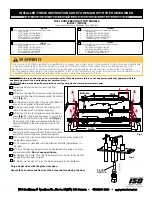
3-2
Asynchronous Transfer Mode (ATM) Module Installation and User Guide
Configuring the ATM Module
Basic ATM Module Configuration Information
This section uses several typical usage and configuration schemes to provide a brief
overview of the ATM module configuration process as a general context for the detailed
command description sections that follow.
ATM Module Characteristics
ATM is a packet transmission technique that uses fixed size data frames called “cells”.
Each cell is 53-bytes long and includes a 5-byte ATM header and 48-byte payload. The
ATM header includes a Virtual Path Identifier (VPI) and a Virtual Circuit Identifier
(VCI). The VPI/VCI pair uniquely identifies a Virtual Circuit (VC) which is a logical
connection configured on a physical ATM link. Each VC is a separate point-to-point
connection and the ATM network uses the VPI/VCI in each ATM cell to determine how
to forward the cell. Intermediate ATM switches in the network may change the
VPI/VCI values for a VC so the same VC may be identified by a different VPI/VCI at
the termination point. Multiple VCs can be configured on a single physical ATM link.
The ATM module supports Permanent Virtual Circuits PVCs which are VCs that have
been pre-provisioned by the ATM service provider. To connect to a service provider’s
ATM network using a PVC, the VPI and VCI values must be obtained from the ATM
service provider. The ATM module does not support Switched Virtual Connections
(SVCs) which are VCs that are dynamically established using a signalling protocol.
The ATM module segments each outbound packet into ATM cells before transmitting
and conversely re-assembles received cells into packets. Before segmenting a packet, the
ATM module encapsulates the packet in an ATM Adaption Layer (AAL-5) format as
defined in IETF RFC 2648/1483. The ATM module supports two types of encapsulations
as defined in IETF RFC 2648/1483: LLC Encapsulation for Routed Protocols and LLC
Encapsulation for Bridged Protocols. After the packets are segmented into ATM cells,
the cells are transported inside a SONET payload.
The contents of ATM cells can be scrambled to randomize the pattern of 1s and 0s
carried in the cells. Randomizing the bits can prevent long strings of all 1s and 0s.
Transitions between 1s and 0s are used by the physical layer to maintain clocking and
achieve signal synchronization which can improve the performance of delineating
received ATM cells. The ATM module supports cell scrambling.
The ATM module responds to Operations, Administrations and Maintenance (OAM) F5
loopback cells but does not generate them. Loopback can be used to detect if the remote
device is still active.
Содержание BlackDiamond 6800
Страница 8: ...viii Asynchronous Transfer Mode ATM Module Installation and User Guide ...
Страница 10: ...x Asynchronous Transfer Mode ATM Module Installation and User Guide ...
Страница 14: ...xiv Asynchronous Transfer Mode ATM Module Installation and User Guide ...
Страница 100: ...A 8 Asynchronous Transfer Mode ATM Module Installation and User Guide ...
Страница 104: ...B 4 Asynchronous Transfer Mode ATM Module Installation and User Guide ...
















































